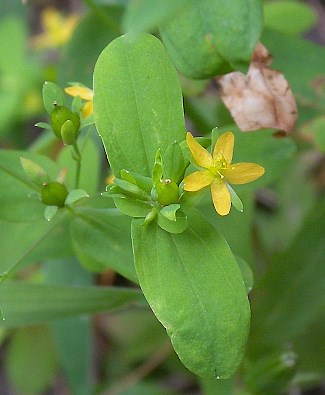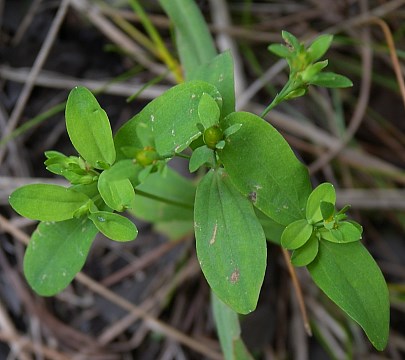Description:
This wildflower is either a short-lived perennial or summer annual.
It is usually a short bushy plant about 4–18" tall, although larger
specimens have been reported. The much-branched stems are light to
medium green, glabrous, sometimes glaucous, 4-angled or terete, and
sometimes narrowly winged. The opposite leaves are about ½–1½" long,
¼–¾" across, and sessile; they are medium green, broadly oblong to oval
in shape with 1-5 prominent veins, smooth among their margins, and
glabrous. The upper stems terminate in small clusters (cymes) of
flowers. Individual flowers are ¼" across, consisting of 5 yellow to
yellow-orange petals, 5 green sepals, a light green pistil with 3 styles, and 5-15
stamens. The petals and sepals are about the same length; the petals
are oblong, while the sepals are linear-oblong. The peduncle and
pedicels of the flowers are light to medium green, slender, and
glabrous; sometimes there are small scale-like bracts near the area
where two pedicels diverge. These bracts are linear-lanceolate in shape
and much smaller in size than the leaves. The blooming period occurs
from mid-summer to early fall and lasts about 2-3 months. Usually, only
a few flowers are in bloom at the same time. Each flower is replaced by
an ovoid seed capsule that becomes up to 1/3" (8 mm.) tall at maturity;
this
glabrous capsule has remnants of the styles at its apex and it is
3-celled. Each cell of the capsule contains numerous tiny seeds that
are dark-colored, narrowly oblongoid, and somewhat flattened. The
persistent sepals become enlarged as the seed capsules mature; the
sepals are usually about the same length or a little longer than
full-sized capsules. This wildflower reproduces by reseeding itself.
petals, 5 green sepals, a light green pistil with 3 styles, and 5-15
stamens. The petals and sepals are about the same length; the petals
are oblong, while the sepals are linear-oblong. The peduncle and
pedicels of the flowers are light to medium green, slender, and
glabrous; sometimes there are small scale-like bracts near the area
where two pedicels diverge. These bracts are linear-lanceolate in shape
and much smaller in size than the leaves. The blooming period occurs
from mid-summer to early fall and lasts about 2-3 months. Usually, only
a few flowers are in bloom at the same time. Each flower is replaced by
an ovoid seed capsule that becomes up to 1/3" (8 mm.) tall at maturity;
this
glabrous capsule has remnants of the styles at its apex and it is
3-celled. Each cell of the capsule contains numerous tiny seeds that
are dark-colored, narrowly oblongoid, and somewhat flattened. The
persistent sepals become enlarged as the seed capsules mature; the
sepals are usually about the same length or a little longer than
full-sized capsules. This wildflower reproduces by reseeding itself.
Cultivation:
The preference is full sun to light shade, wet to moist conditions, and
acidic soil that is either sandy or rocky.
Range & Habitat:
The native Dwarf St. John's Wort (Hypericum mutilum) is occasional in most areas of
Illinois,
otherwise it is uncommon or absent (see Distribution
Map). Habitats include sandy forests in floodplain areas,
sandy swamps, wet to moist sand prairies, gravelly seeps and springs
with an acidic bedrock (e.g., sandstone), damp depressions in sandstone
glades, damp depressions along sandstone cliffs, low sandy areas along
rivers and ponds, damp depressions in sandy paths, and abandoned sandy
fields. This wildflower is found in both disturbed and little-disturbed
habitats.
Faunal Associations:
The flowers are cross-pollinated primarily by pollen-collecting smaller
bees, especially Halictid bees. Other visitors of the flowers include
Syrphid flies and various beetles, which feed on pollen. Nectar
is not available as a floral reward. Other insects feed destructively
on the foliage, plant juices, and other parts of this St. John's Wort
(Hypericum mutilum) and other St. John's Wort species (Hypericum spp.).
These insect feeders include leaf beetles, aphids, leafhoppers, scale
insects (on woody species only), and the larvae of several moths. See
the Insect Table
for a listing of these species. Some of these insects are oligophagous,
meaning their preferred host plants are St. John's Wort species.
Mammalian
herbivores usually avoid consumption of the foliage because of its
toxicity. The foliage contains hypericin, which produces a
photosensitive reaction to sunlight, particularly in light-skinned
animals, and it can irritate the digestive tract of such animals.

Photographic
Location:
A damp depression in a sandy path at the Iroquois County Conservation
Area in Illinois.
Comments:
This wildflower resembles a dwarf version of the larger and
better-known St. John's Wort species (Hypericum spp.) that are
occasionally cultivated. Other small-flowered St. John's Wort species
(flowers 1/3" across or less) usually have more narrow
leaves and therefore they are easily distinguished from Dwarf St.
John's
Wort (Hypericum mutilum). An exception is Northern St. John's Wort
(Hypericum boreale), which is rare in Illinois. Generally, Northern St.
John's Wort can be distinguished from Dwarf St. John's Wort and other
small-flowered species in this genus by its larger leafy floral bracts.
It also has purple seed capsules that are as
long or longer than its sepals. Dwarf St. John's Wort, in contrast, has
smaller floral bracts and its seed capsules usually remain
green for a longer period of time.